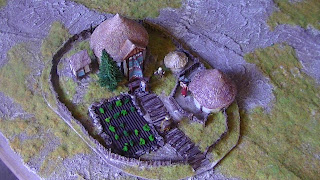The Bronze Age houses are usually small and rectangular, small in size, sometimes with attics on four posts and enclosures for livestock.
Concerning the material culture bordering the Channel, the round house seems to dominate, at the end of the Bronze Age until the beginnings of the Iron Age. It is preceded by a porch. It is this type of habitat that I have chosen to represent. Especially since one of my friends, an archaeologist specialized in this period, has searched this type of habitat and that it is the conversations I had with him that prompted me to develop an army and scenery that time.
Concerning the material culture bordering the Channel, the round house seems to dominate, at the end of the Bronze Age until the beginnings of the Iron Age. It is preceded by a porch. It is this type of habitat that I have chosen to represent. Especially since one of my friends, an archaeologist specialized in this period, has searched this type of habitat and that it is the conversations I had with him that prompted me to develop an army and scenery that time.
I gave this small farm a garden, as is often the case in the Bronze Age in Europe, and an attic raised on stilts (to limit the impact of rodents) and an enclosure for livestock.
The fence around the farm is not really defensive but protects the property from the intrusion of wild animals.
 |
| The inhabitants of the farm |
The figurine of a girl wears a dress copied on that of the burial of the "daughter of Egtved" The photos below are: on the left the burial and on the right a recent reconstruction. Interesting article about this girl here.
 |
| Egtved girl |
 |
| Caithness girl (Anthropological restitution) |






